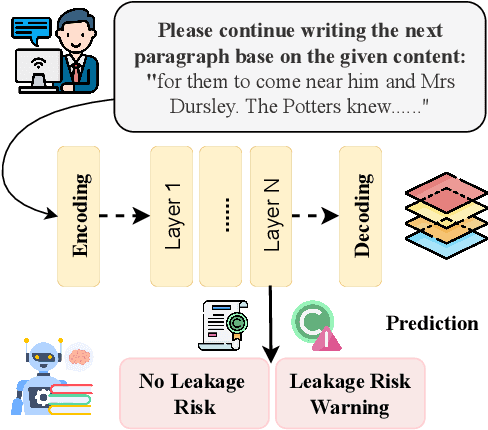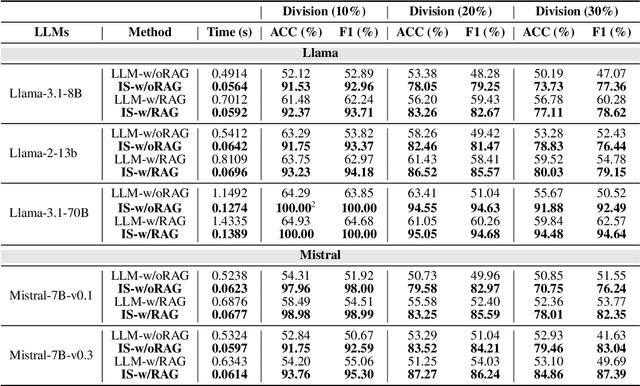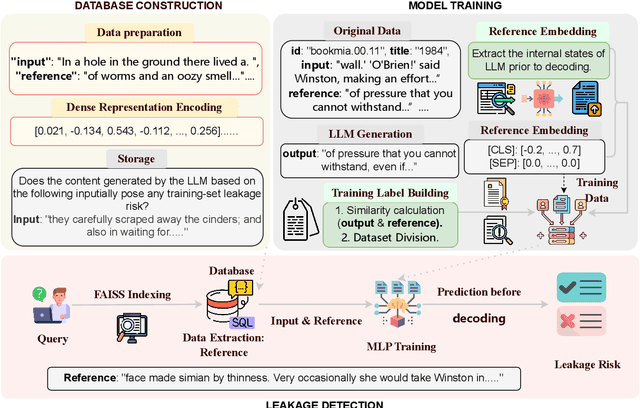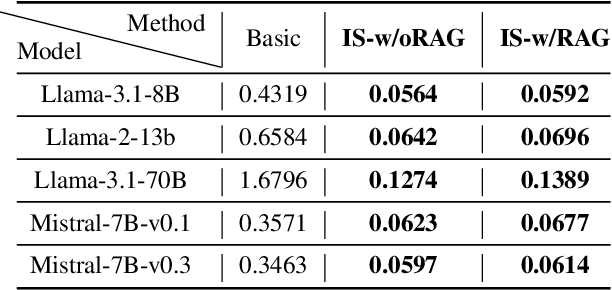Denghui Zhang
ISACL: Internal State Analyzer for Copyrighted Training Data Leakage
Aug 25, 2025



Abstract:Large Language Models (LLMs) have revolutionized Natural Language Processing (NLP) but pose risks of inadvertently exposing copyrighted or proprietary data, especially when such data is used for training but not intended for distribution. Traditional methods address these leaks only after content is generated, which can lead to the exposure of sensitive information. This study introduces a proactive approach: examining LLMs' internal states before text generation to detect potential leaks. By using a curated dataset of copyrighted materials, we trained a neural network classifier to identify risks, allowing for early intervention by stopping the generation process or altering outputs to prevent disclosure. Integrated with a Retrieval-Augmented Generation (RAG) system, this framework ensures adherence to copyright and licensing requirements while enhancing data privacy and ethical standards. Our results show that analyzing internal states effectively mitigates the risk of copyrighted data leakage, offering a scalable solution that fits smoothly into AI workflows, ensuring compliance with copyright regulations while maintaining high-quality text generation. The implementation is available on GitHub.\footnote{https://github.com/changhu73/Internal_states_leakage}
Beyond Reactive Safety: Risk-Aware LLM Alignment via Long-Horizon Simulation
Jun 26, 2025Abstract:Given the growing influence of language model-based agents on high-stakes societal decisions, from public policy to healthcare, ensuring their beneficial impact requires understanding the far-reaching implications of their suggestions. We propose a proof-of-concept framework that projects how model-generated advice could propagate through societal systems on a macroscopic scale over time, enabling more robust alignment. To assess the long-term safety awareness of language models, we also introduce a dataset of 100 indirect harm scenarios, testing models' ability to foresee adverse, non-obvious outcomes from seemingly harmless user prompts. Our approach achieves not only over 20% improvement on the new dataset but also an average win rate exceeding 70% against strong baselines on existing safety benchmarks (AdvBench, SafeRLHF, WildGuardMix), suggesting a promising direction for safer agents.
Atomic Reasoning for Scientific Table Claim Verification
Jun 08, 2025Abstract:Scientific texts often convey authority due to their technical language and complex data. However, this complexity can sometimes lead to the spread of misinformation. Non-experts are particularly susceptible to misleading claims based on scientific tables due to their high information density and perceived credibility. Existing table claim verification models, including state-of-the-art large language models (LLMs), often struggle with precise fine-grained reasoning, resulting in errors and a lack of precision in verifying scientific claims. Inspired by Cognitive Load Theory, we propose that enhancing a model's ability to interpret table-based claims involves reducing cognitive load by developing modular, reusable reasoning components (i.e., atomic skills). We introduce a skill-chaining schema that dynamically composes these skills to facilitate more accurate and generalizable reasoning with a reduced cognitive load. To evaluate this, we create SciAtomicBench, a cross-domain benchmark with fine-grained reasoning annotations. With only 350 fine-tuning examples, our model trained by atomic reasoning outperforms GPT-4o's chain-of-thought method, achieving state-of-the-art results with far less training data.
DEL-ToM: Inference-Time Scaling for Theory-of-Mind Reasoning via Dynamic Epistemic Logic
May 22, 2025Abstract:Theory-of-Mind (ToM) tasks pose a unique challenge for small language models (SLMs) with limited scale, which often lack the capacity to perform deep social reasoning. In this work, we propose DEL-ToM, a framework that improves ToM reasoning through inference-time scaling rather than architectural changes. Our approach decomposes ToM tasks into a sequence of belief updates grounded in Dynamic Epistemic Logic (DEL), enabling structured and transparent reasoning. We train a verifier, called the Process Belief Model (PBM), to score each belief update step using labels generated automatically via a DEL simulator. During inference, candidate belief traces generated by a language model are evaluated by the PBM, and the highest-scoring trace is selected. This allows SLMs to emulate more deliberate reasoning by allocating additional compute at test time. Experiments across multiple model scales and benchmarks show that DEL-ToM consistently improves performance, demonstrating that verifiable belief supervision can significantly enhance ToM abilities of SLMs without retraining.
RM-R1: Reward Modeling as Reasoning
May 05, 2025Abstract:Reward modeling is essential for aligning large language models (LLMs) with human preferences, especially through reinforcement learning from human feedback (RLHF). To provide accurate reward signals, a reward model (RM) should stimulate deep thinking and conduct interpretable reasoning before assigning a score or a judgment. However, existing RMs either produce opaque scalar scores or directly generate the prediction of a preferred answer, making them struggle to integrate natural language critiques, thus lacking interpretability. Inspired by recent advances of long chain-of-thought (CoT) on reasoning-intensive tasks, we hypothesize and validate that integrating reasoning capabilities into reward modeling significantly enhances RM's interpretability and performance. In this work, we introduce a new class of generative reward models -- Reasoning Reward Models (ReasRMs) -- which formulate reward modeling as a reasoning task. We propose a reasoning-oriented training pipeline and train a family of ReasRMs, RM-R1. The training consists of two key stages: (1) distillation of high-quality reasoning chains and (2) reinforcement learning with verifiable rewards. RM-R1 improves LLM rollouts by self-generating reasoning traces or chat-specific rubrics and evaluating candidate responses against them. Empirically, our models achieve state-of-the-art or near state-of-the-art performance of generative RMs across multiple comprehensive reward model benchmarks, outperforming much larger open-weight models (e.g., Llama3.1-405B) and proprietary ones (e.g., GPT-4o) by up to 13.8%. Beyond final performance, we perform thorough empirical analysis to understand the key ingredients of successful ReasRM training. To facilitate future research, we release six ReasRM models along with code and data at https://github.com/RM-R1-UIUC/RM-R1.
Sensitivity Meets Sparsity: The Impact of Extremely Sparse Parameter Patterns on Theory-of-Mind of Large Language Models
Apr 05, 2025



Abstract:This paper investigates the emergence of Theory-of-Mind (ToM) capabilities in large language models (LLMs) from a mechanistic perspective, focusing on the role of extremely sparse parameter patterns. We introduce a novel method to identify ToM-sensitive parameters and reveal that perturbing as little as 0.001% of these parameters significantly degrades ToM performance while also impairing contextual localization and language understanding. To understand this effect, we analyze their interaction with core architectural components of LLMs. Our findings demonstrate that these sensitive parameters are closely linked to the positional encoding module, particularly in models using Rotary Position Embedding (RoPE), where perturbations disrupt dominant-frequency activations critical for contextual processing. Furthermore, we show that perturbing ToM-sensitive parameters affects LLM's attention mechanism by modulating the angle between queries and keys under positional encoding. These insights provide a deeper understanding of how LLMs acquire social reasoning abilities, bridging AI interpretability with cognitive science. Our results have implications for enhancing model alignment, mitigating biases, and improving AI systems designed for human interaction.
ALinFiK: Learning to Approximate Linearized Future Influence Kernel for Scalable Third-Parity LLM Data Valuation
Mar 02, 2025Abstract:Large Language Models (LLMs) heavily rely on high-quality training data, making data valuation crucial for optimizing model performance, especially when working within a limited budget. In this work, we aim to offer a third-party data valuation approach that benefits both data providers and model developers. We introduce a linearized future influence kernel (LinFiK), which assesses the value of individual data samples in improving LLM performance during training. We further propose ALinFiK, a learning strategy to approximate LinFiK, enabling scalable data valuation. Our comprehensive evaluations demonstrate that this approach surpasses existing baselines in effectiveness and efficiency, demonstrating significant scalability advantages as LLM parameters increase.
A Survey on Data-Centric AI: Tabular Learning from Reinforcement Learning and Generative AI Perspective
Feb 12, 2025


Abstract:Tabular data is one of the most widely used data formats across various domains such as bioinformatics, healthcare, and marketing. As artificial intelligence moves towards a data-centric perspective, improving data quality is essential for enhancing model performance in tabular data-driven applications. This survey focuses on data-driven tabular data optimization, specifically exploring reinforcement learning (RL) and generative approaches for feature selection and feature generation as fundamental techniques for refining data spaces. Feature selection aims to identify and retain the most informative attributes, while feature generation constructs new features to better capture complex data patterns. We systematically review existing generative methods for tabular data engineering, analyzing their latest advancements, real-world applications, and respective strengths and limitations. This survey emphasizes how RL-based and generative techniques contribute to the automation and intelligence of feature engineering. Finally, we summarize the existing challenges and discuss future research directions, aiming to provide insights that drive continued innovation in this field.
Internal Activation as the Polar Star for Steering Unsafe LLM Behavior
Feb 04, 2025



Abstract:Large language models (LLMs) have demonstrated exceptional capabilities across a wide range of tasks but also pose significant risks due to their potential to generate harmful content. Although existing safety mechanisms can improve model safety, they often lead to overly cautious behavior and fail to fully utilize LLMs' internal cognitive processes. Drawing inspiration from cognitive science, where humans rely on reflective reasoning (System 2 thinking) to regulate language and behavior, we empirically demonstrate that LLMs also possess a similar capacity for internal assessment and regulation, which can be actively detected. Building on this insight, we introduce SafeSwitch, a framework that dynamically regulates unsafe outputs by monitoring and utilizing the model's internal states. Our empirical results show that SafeSwitch reduces harmful outputs by over 80% on safety benchmarks while maintaining strong utility. Compared to traditional safety alignment methods, SafeSwitch delivers more informative and context-aware refusals, demonstrates resilience to unseen queries, and achieves these benefits while only tuning less than 6% of the original parameters. These features make SafeSwitch a promising approach for implementing nuanced safety controls in LLMs.
EscapeBench: Pushing Language Models to Think Outside the Box
Dec 18, 2024Abstract:Language model agents excel in long-session planning and reasoning, but existing benchmarks primarily focus on goal-oriented tasks with explicit objectives, neglecting creative adaptation in unfamiliar environments. To address this, we introduce EscapeBench, a benchmark suite of room escape game environments designed to challenge agents with creative reasoning, unconventional tool use, and iterative problem-solving to uncover implicit goals. Our results show that current LM models, despite employing working memory and Chain-of-Thought reasoning, achieve only 15% average progress without hints, highlighting their limitations in creativity. To bridge this gap, we propose EscapeAgent, a framework designed to enhance creative reasoning through Foresight (innovative tool use) and Reflection (identifying unsolved tasks). Experiments show that EscapeAgent can execute action chains over 1,000 steps while maintaining logical coherence. It navigates and completes games with up to 40% fewer steps and hints, performs robustly across varying difficulty levels, and achieves higher action success rates with more efficient and innovative puzzle-solving strategies. All the data and codes are released.
 Add to Chrome
Add to Chrome Add to Firefox
Add to Firefox Add to Edge
Add to Edge